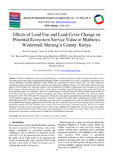| dc.description.abstract | Wetlands in Mathioya watershed are declining due to continued alterations caused by human and natural factors. This study assessed the effects of spatiotemporal changes in Land Use and Land Cover (LULC), on potential ecosystem service value in Mathioya watershed, Murang’a County, Kenya. We considered the period between 1987 and 2020. Supervised classification using maximum likelihood classifier was performed in ERDAS imagine v.15. The values obtained from the analysis of LULC maps were then used together with the global data for habitats to approximate the ecosystem service value (ESV) change within the watershed. Six LULC classes namely, forestland, wetlands, agricultural land, water bodies, built-up areas and barren lands, were identified. Analysis of Landsat images revealed that between 1987 and 2020, human activity led to decrease in the area covered by wetlands, forestland, water bodies, and barren land. Area under these land cover classes decreased by 45%, 34%, 50% and 27%, respectively. During the study period, agricultural land and built-up areas increased by 43% and 85%, respectively. Changes in LULC resulted in decline of ESV from $368.5 million/ha/year in 1987 to $337.7 million/ha/year in 2020. With respect to individual ecosystem services, regulating services declined. Between 1987 and 2020, water regulation and climate regulation declined by 48% and 16%, respectively. However, provisioning services such as food production increased by 34%. Wetlands play a critical role in the provision of ecosystem services. The loss of wetlands translated to decline of critical ecosystem services such as water regulation. Eventually, this will lead to poor water quality within the watershed and the entire County, thus impacting negatively on the health of the locals. Hence, there is a need for urgent action to prevent the current trend of wetland loss within Mathioya watershed. | en_US |

